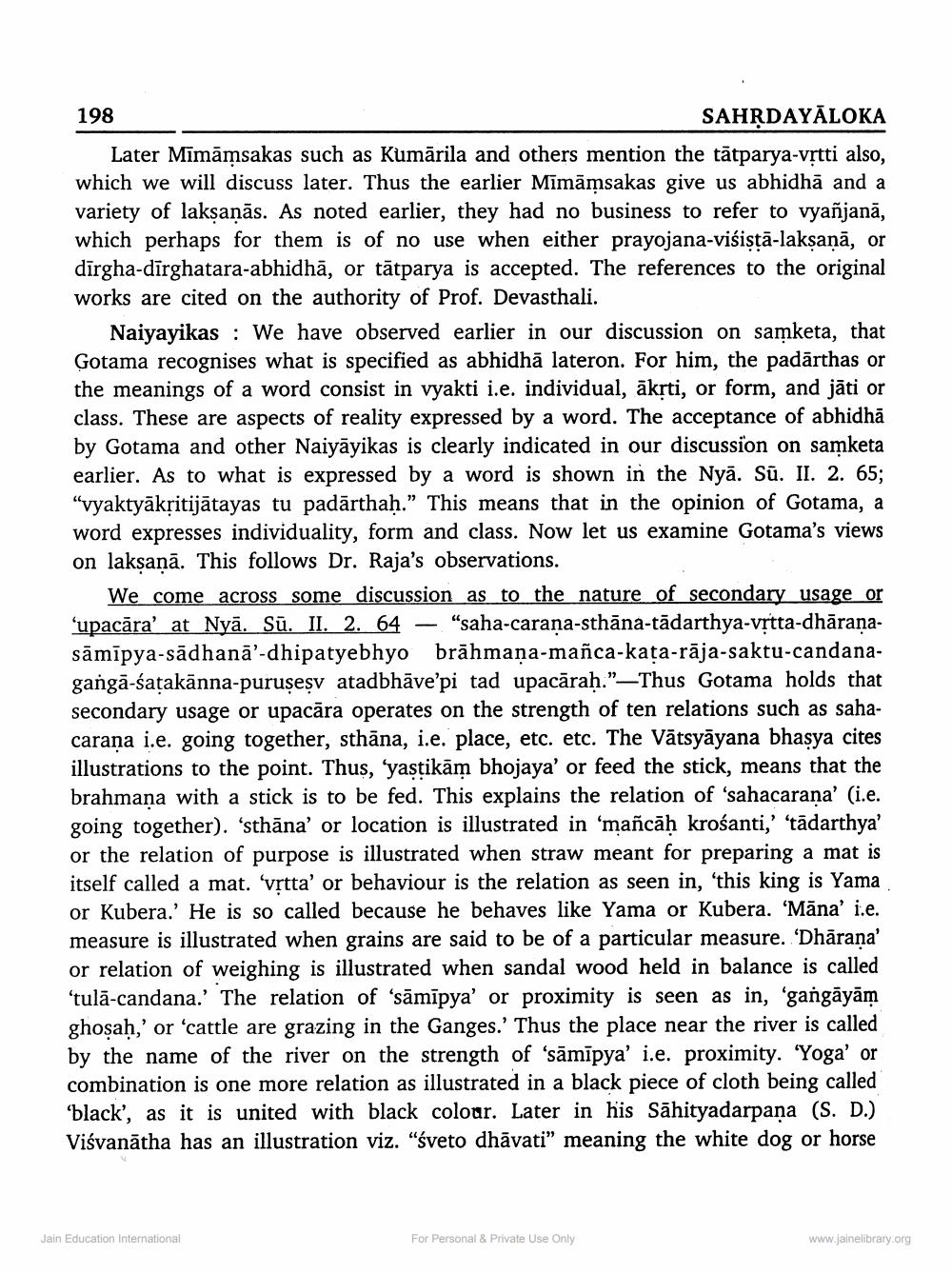________________
198
SAHRDAYĀLOKA Later Mimāmsakas such as Kumārila and others mention the tātparya-vrtti also, which we will discuss later. Thus the earlier Mīmāmsakas give us abhidhā and a variety of laksaņās. As noted earlier, they had no business to refer to vyañjanā, which perhaps for them is of no use when either prayojana-viśistā-lakṣaṇā, or dīrgha-dirghatara-abhidhā, or tātparya is accepted. The references to the original works are cited on the authority of Prof. Devasthali.
Naiyayikas : We have observed earlier in our discussion on samketa, that Gotama recognises what is specified as abhidhā lateron. For him, the padārthas or the meanings of a word consist in vyakti i.e. individual, āksti, or form, and jāti or class. These are aspects of reality expressed by a word. The acceptance of abhidhā by Gotama and other Naiyāyikas is clearly indicated in our discussion on samketa earlier. As to what is expressed by a word is shown in the Nyā. Sū. II. 2. 65; "vyaktyāksitijātayas tu padārthah.” This means that in the opinion of Gotama, a word expresses individuality, form and class. Now let us examine Gotama's views on laksaņā. This follows Dr. Raja's observations.
We come across some discussion as to the nature of secondary usage or ‘upacāra' at Nyā. Sū. II. 2. 64 – "saha-carana-sthāna-tādarthya-vrtta sāmīpya-sādhanā’-dhipatyebhyo brāhmana-mañca-kata-rāja-saktu-candanagangā-śatakanna-purusesv atadbhāve'pi tad upacārah.”—Thus Gotama holds that secondary usage or upacāra operates on the strength of ten relations such as sahacarana i.e. going together, sthāna, i.e. place, etc. etc. The Vātsyāyana bhasya cites
llustrations to the point. Thus, 'yastikām bhojaya' or feed the stick, means that the brahmana with a stick is to be fed. This explains the relation of 'sahacarana' (i.e. going together). 'sthāna' or location is illustrated in ‘mañcāḥ krośanti,' 'tādarthya' or the relation of purpose is illustrated when straw meant for preparing a mat is itself called a mat. 'vrtta' or behaviour is the relation as seen in, 'this king is Yama or Kubera.' He is so called because he behaves like Yama or Kubera. “Māna' i.e. measure is illustrated when grains are said to be of a particular measure. 'Dhārana' or relation of weighing is illustrated when sandal wood held in balance is called ‘tulā-candana.' The relation of 'sāmīpya' or proximity is seen as in, 'gangāyām
sah,' or 'cattle are grazing in the Ganges.' Thus the place near the river is called by the name of the river on the strength of 'sāmīpya' i.e. proximity. 'Yoga' or combination is one more relation as illustrated in a black piece of cloth being called 'black', as it is united with black colour. Later in his Sāhityadarpana (S. D.) Visvanātha has an illustration viz. "sveto dhāvati" meaning the white dog or horse
Jain Education International
For Personal & Private Use Only
www.jainelibrary.org




